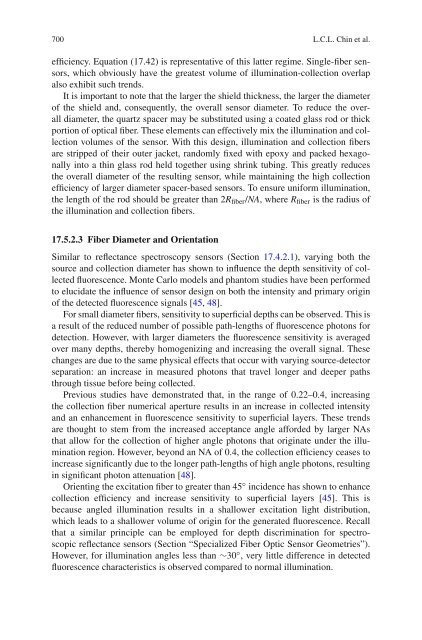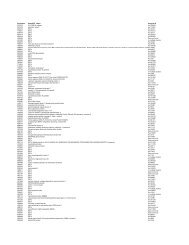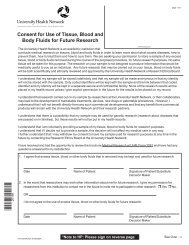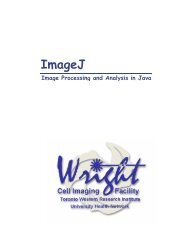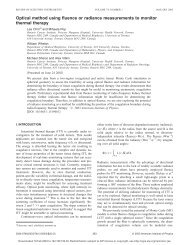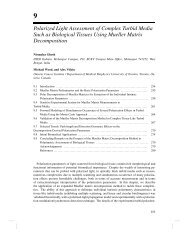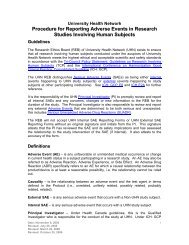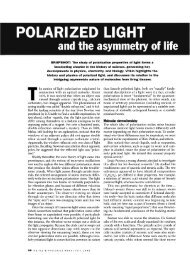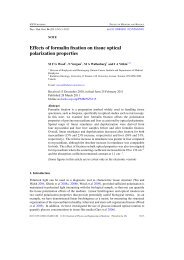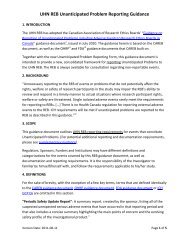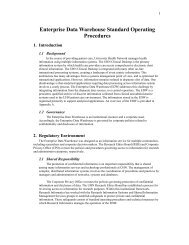Optical Fiber Sensors for Biomedical Applications
Optical Fiber Sensors for Biomedical Applications
Optical Fiber Sensors for Biomedical Applications
You also want an ePaper? Increase the reach of your titles
YUMPU automatically turns print PDFs into web optimized ePapers that Google loves.
700 L.C.L. Chin et al.efficiency. Equation (17.42) is representative of this latter regime. Single-fiber sensors,which obviously have the greatest volume of illumination-collection overlapalso exhibit such trends.It is important to note that the larger the shield thickness, the larger the diameterof the shield and, consequently, the overall sensor diameter. To reduce the overalldiameter, the quartz spacer may be substituted using a coated glass rod or thickportion of optical fiber. These elements can effectively mix the illumination and collectionvolumes of the sensor. With this design, illumination and collection fibersare stripped of their outer jacket, randomly fixed with epoxy and packed hexagonallyinto a thin glass rod held together using shrink tubing. This greatly reducesthe overall diameter of the resulting sensor, while maintaining the high collectionefficiency of larger diameter spacer-based sensors. To ensure uni<strong>for</strong>m illumination,the length of the rod should be greater than 2R fiber /NA, where R fiber is the radius ofthe illumination and collection fibers.17.5.2.3 <strong>Fiber</strong> Diameter and OrientationSimilar to reflectance spectroscopy sensors (Section 17.4.2.1), varying both thesource and collection diameter has shown to influence the depth sensitivity of collectedfluorescence. Monte Carlo models and phantom studies have been per<strong>for</strong>medto elucidate the influence of sensor design on both the intensity and primary originof the detected fluorescence signals [45, 48].For small diameter fibers, sensitivity to superficial depths can be observed. This isa result of the reduced number of possible path-lengths of fluorescence photons <strong>for</strong>detection. However, with larger diameters the fluorescence sensitivity is averagedover many depths, thereby homogenizing and increasing the overall signal. Thesechanges are due to the same physical effects that occur with varying source-detectorseparation: an increase in measured photons that travel longer and deeper pathsthrough tissue be<strong>for</strong>e being collected.Previous studies have demonstrated that, in the range of 0.22–0.4, increasingthe collection fiber numerical aperture results in an increase in collected intensityand an enhancement in fluorescence sensitivity to superficial layers. These trendsare thought to stem from the increased acceptance angle af<strong>for</strong>ded by larger NAsthat allow <strong>for</strong> the collection of higher angle photons that originate under the illuminationregion. However, beyond an NA of 0.4, the collection efficiency ceases toincrease significantly due to the longer path-lengths of high angle photons, resultingin significant photon attenuation [48].Orienting the excitation fiber to greater than 45 ◦ incidence has shown to enhancecollection efficiency and increase sensitivity to superficial layers [45]. This isbecause angled illumination results in a shallower excitation light distribution,which leads to a shallower volume of origin <strong>for</strong> the generated fluorescence. Recallthat a similar principle can be employed <strong>for</strong> depth discrimination <strong>for</strong> spectroscopicreflectance sensors (Section “Specialized <strong>Fiber</strong> Optic Sensor Geometries”).However, <strong>for</strong> illumination angles less than ∼30 ◦ , very little difference in detectedfluorescence characteristics is observed compared to normal illumination.


